|
Golf In Full Swing!!!
Jory Horsley, Asst. Supt, The Powder Horn, Sheridan, WY:

"There has been a lot of activity around The Powder Horn, as the weather remains exceptional. The greens are looking spectacular and are now being cut every other day to allow some growth. This also helps to not put a lot of added pressure on the greens while they are coming out of winter. They will gradually be cut to lower and lower heights as the summer progresses.
If too much of the leaf is taken it will scalp the greens and it kills the turf, so as the roots grow longer we nip away just a little bit more of the leaf until it is at a playable height. This will also increase the speed of the green as there is less leaf blade restricting ball movement, basically a resistance which slows the ball. Mid-summer the leaf is short and the greens are hard. They are fast and smooth, but while the turf is a bit longer and there is some resistance it is the time to get some good putting practice in.
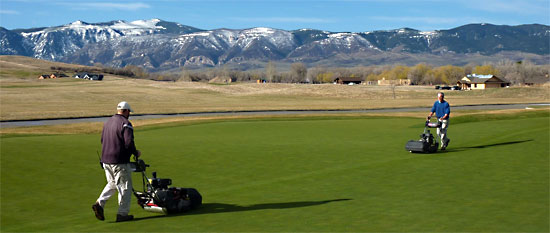
Eagle putting green being walk mowed by John Hathaway and Tom Judd. A beautiful place to work and golf!.
Our fairways are starting to get their luster back day by day, and the little bit of rain we received last night helped. Hopefully we continue to get some moisture at night in the future, or we will experience a much drier summer."
Visit The Powder Horn blog at powderhorngcm.blogspot.com.
|
 |
|
Perfect practice...
Brian Boyer, Cinnabar Hills Golf Club, San Jose, CA:
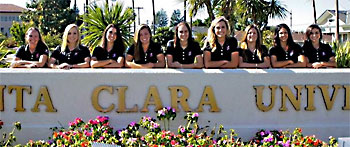  "For the past couple of months Cinnabar Hills has been a weekly practice facility for the Women's Golf Team of Santa Clara University. They were here practicing again this past week and I saw something that just warmed my heart.
One of the girl's was practicing her putting while standing on a towel, like I wish so many of our customers would do. By doing this, footprints will not be burned into the putting surface like the picture shown. It really helps having somebody out there leading by example and I thank the team and their coach for doing things the right way."
Visit Brian's blog at cinnabarhills.blogspot.com
|
 |
|
New Enter and Exit signs...
Steve Wilson, CGCS, Meadowbrook Country Club, Overland Park, KS:
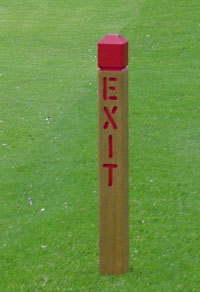  "You may have noticed our new cart "enter" and "exit" posts. Gone are the old cart signs placed in the fairway with an arrow on them to indicate when your golf cart should return to the path. These new cedar posts that we made this winter are a little more aesthetically pleasing but serve essentially the same purpose.
We ask that your cart remain on the cart path once leaving the tee area until after you pass the "enter" post (placed along the cart path edge). Once you leave the path and enter the fairway we ask that your cart remain in the fairway until you reach the "exit" sign. Once you have reached the "exit" sign (or before) your cart should return to the cart path and stay on the path for the remainder of the hole.
We also ask that carts refrain from driving and parking in the rough at all times except for the purpose of entering of exiting the fairways. The reason for these cart rules are simple: the zoysia grass fairays are much more tolerant of cart traffic and compaction once actively growing than are our cool-season roughs. These rules will be especially important this year with increased cart traffic from our increasing membership roster (go Meadowbrook!!) and our new cart-inclusive membership structure."
Visit Steve's blog at meadowbrookccturfgrass.blogspot.com.
|
 |
|
Very dry!
Ben Rink, Champaign Country Club, Champaign, IL:
 "The crew was hard at work today getting the course mowed and ready for the Easter weekend, but Assistant Superintendent Ben Christie and I spent most of the day chasing wilt. Yes, we are hand watering dry spots in April! Already I have run several full irrigation cycles on the golf course and I will be turning it up tonight in preparation for Monday's greens aerification.
Never before have I seen the golf course this dry so early in the year! With the 10 day forecast showing little signs of any precipitation, we will continue to pump water to keep up with dry turf. Keep your fingers crossed for rain in the next week or so..."

Visit Ben's blog at cccgolfcourseupdate.blogspot.com.
|
 |
|
Scaping the land...
Jim Alwine, Stockton Golf and Country Club, Stockton, CA:
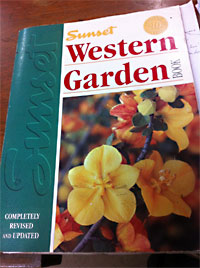  "My Western Garden Book has been getting a workout over the last few years as we continue to improve some of our landscape areas. Our region can support the growth of a diverse set of plant life and the possibilities are endless.
Our recent renovation of the entry to the tee box on #4 included an arid landscape and some decomposed granite used as mulch. The plantings in this area included some muhly grass, leatherleaf sedge, 'little john' bottle brush, and 'Karl Foerster' feather reed grass. The desert look has been well received by the membership and I hope to incorporate this design to a few new areas. Plants like these are very maintenance friendly and labor is reduced because of less grass and weed eating locations."
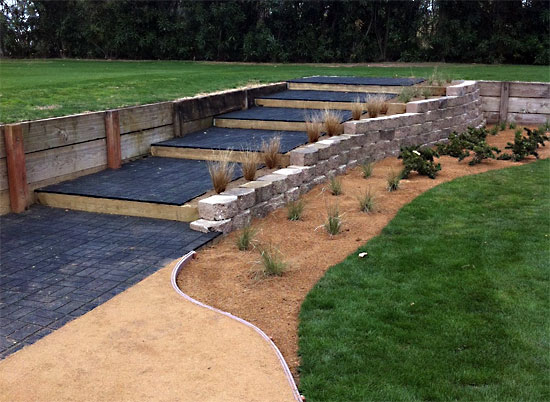
Visit Jim's blog at sgccturf.blogspot.com
|
 |
|
Unusual sprinkler repair...
Rick Tegtmeier, CGCS, Des Moines Golf & Country Club, West Des Moines, IA:
  "We came across a very unusual problem on the North Course. We had a sprinkler head that was leaking causing a wet spot on one of our rough heads. We decided to dig it up and replace it. What we found was a tree root was growing right around the head putting pressure on it, causing it to leak. Cut the root away and problem was solved."
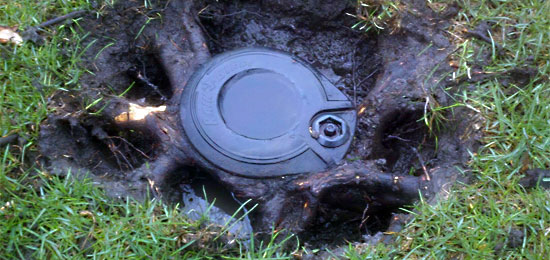
Visit Rick's blog at dmgcc.blogspot.com.
|
 |
|
Frost...
Steve Cook, CGCS MG, Oakland Hills Country Club, Bloomfield Hills, MI:
  "Frost is basically frozen dew that has crystallized on the grass, making it hard and brittle. A grass blade is actually 90 percent water, therefore it also freezes. Because of the short mowing height (sometimes as low as 1/8 inch) and fragile nature of the turf, putting greens are most affected by frost. Walking on frost-covered greens causes the plant to break and cell walls to rupture, thereby losing its ability to function normally. When the membrane is broken, much like an egg, it cannot be put back together.
Golfers who ignore frost delays will not see immediate damage. The proof generally comes 48-72 hours later as the plant leaves turn brown and die. The result is a thinning of the putting surface and a weakening of the plant. The greens in turn become more susceptible to disease and weeds.
While it may not appear to be much of an issue if a foursome begins play early on frost covered greens, consider the number of footprints that may occur on any given hole by one person is approximately 60. Multiply that by 18 holes with an average of 200 rounds per day and the result is 216,000 footprints on greens in a day or 6,480,000 in a month."
Visit Steve's blog at ohccturf.blogspot.com.
|
 |
Look who's stylin' now! Rob Dorsch, CGCS, of Richter Park Golf Club in Danbury, CT, has a new blog theme with custom header courtesy of TurfNet. We would be happy to do that for other TurfNet member/bloggers as well. All we need are a few good course photos (at least 1000px wide), a club logo and a few head shots to work with.

|
 |
|
About our Blog Aggregator: Many superintendents are now hosting private blogs to better communicate with their golfers and/or members. Beyond local weather and course conditions, there is a great deal of information about projects, methodologies and techniques that would be of value to other superintendents — hence our Turf Blog Aggregator. As every blogger struggles occasionally with content, we also include posts intended to educate golfers about turf maintenance for others to use as a template for their own blogs.
Miss any previous issues of TBA? You can find them all here.
Turf Blog Aggregator(TM) is a trademark of Turnstile Media Group.
|
|